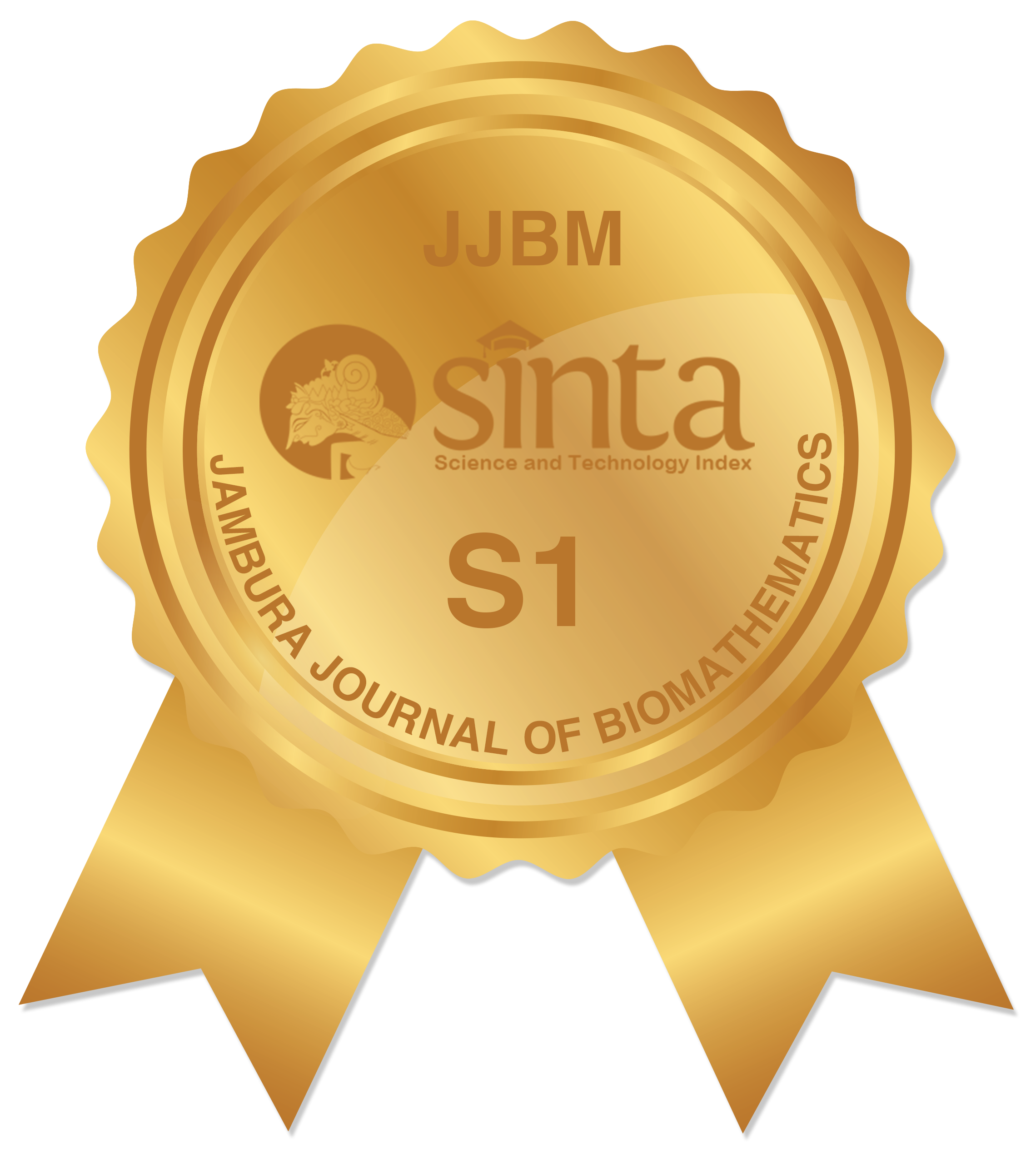Mathematical Modeling on the Transmission Dynamics of Diphtheria with Optimal Control Strategies
Abstract
Diphtheria is an acute bacterial infection caused by Corynebacterium diphtheriae, characterized by the formation of a pseudo-membrane in the throat, which can lead to airway obstruction and systemic complications. Despite the availability of effective vaccines, diphtheria remains a significant public health concern in many regions, particularly in areas with low immunization coverage. In this study, we formulated and rigorously analyzed a deter ministic epidemiological mathematical model to gain insight into the transmission dynamics of Diphtheria infection, incorporating the concentration of Corynebacterium Diphtheriae in the environment. The analysis of the model begins with the computation of the basic reproduction number and the examination of the local stability of the disease-free equilibrium using the Routh-Hurwitz criterion. An in-depth analysis of the model reveals that the model undergoes the phenomenon of backward bifurcation. This characteristic poses significant hurdles in effectively controlling Diph theria infection within the population. However, under the assumption of no re-infection of Diphtheria infection after recovery, the disease-free equilibrium point is globally asymptotically stable whenever the basic reproduction num ber is less than one. Furthermore, the sensitivity analysis of the basic reproduction number was carried out in order to determine the impact of each of the model basic parameters that contribute to the transmission of the disease. Utilizing the optimal control theory to effectively curb the spread of Diphtheria, We introduced two time dependent control measures, to mitigate the spread of Diphtheria. These time dependent control measures represent preventive actions, such as public enlightenment campaign to sensitize and educate the general public on the dynamics of Diph theria and proper personal hygiene which includes regular washing of hands to prevent susceptible individuals from acquiring Diphtheria, and environmental sanitation practices such as cleaning of surfaces and door handle to reduced the concentration of Corynebacterium diphtheriae in the environment. The results from the numerical simulations reveal that Diphtheria infection can successfully be controlled and mitigated within the population if we can increase the vaccination rate and the decay rate of Corynebacterium Diphtheriae in the environment, as well as properly and effectively implementing these optimal control measures simultaneously.
Keywords
Full Text:
PDFReferences
M. Muscat et al., “Diphtheria in the who european region, 2010 to 2019,” Eurosurveillance, vol. 27, no. 8, p. 2100058, 2022. DOI:10.2807/1560-7917.ES.2022.27.8.2100058
A. Raza et al., “Vaccination gaps and resurgence of diphtheria in nigeria: An outbreak simmering for a catastrophe,” New Microbes and New Infections, vol. 55, p. 101187, 2023. DOI:10.1016/j.nmni.2023.101187
T. Tiwari and M. Wharton, “Diphtheria toxoid in: Plotkin sa, orenstein wa, offit pa (eds) vaccines. 6th edn saunders,” 2013.
S. M. Salim and F. M. Hamza, “Trends and geographical distribution of diphtheria in nigeria: A re-emerging disease,” Biology and LifeSciences Forum, vol. 31, no. 1, p. 22, 2024. DOI:10.3390/ECM2023-16693
L. Chêne et al., “Cutaneous diphtheria from 2018 to 2022: an observational, retrospective study of epidemiological, microbiological, clinical, and therapeutic characteristics in metropolitan france,” Emerging microbes & infections, vol. 13, no. 1, p. 2408324, 2024. DOI:10.1080/22221751.2024.2408324
M. Sohaib et al., “Mathematical modeling and numerical simulation of hiv infection model,” Results in Applied Mathematics, vol. 7, p. 100118, 2020. DOI:10.1016/j.rinam.2020.100118
M. M. Ojo et al., “Mathematical model for control of tuberculosis epidemiology,” Journal of Applied Mathematics and Computing, vol. 69, no. 1, pp. 69–87, 2023. DOI:10.1007/s12190-022-01734-x
E. Ndamuzi and P. Gahungu, “Mathematical modeling of malaria transmission dynamics: case of burundi,” Journal of applied mathematics and physics, vol. 9, no. 10, pp. 2447–2460, 2021. DOI:10.4236/jamp.2021.910156
S. Tchoumi et al., “Malaria and covid-19 co-dynamics: A mathematical model and optimal control,” Applied mathematical modelling, vol. 99, pp. 294–327, 2021. DOI:10.1016/j.apm.2021.06.016
F. A. Oguntolu et al., “Mathematical model on the transmission dynamics of leptospirosis in human and animal population with optimal control strategies using real statistical data,” Quality & Quantity, pp. 1–40, 2024. DOI:10.1007/s11135-024-02016-3
J. Wang, “Mathematical models for covid-19: applications, limitations, and potentials,” Journal of public health and emergency, vol. 4, 2020. DOI:10.21037/jphe-2020-05
S. A. Jose et al., “Understanding covid-19 propagation: a comprehensive mathematical model with caputo fractional derivatives for thailand,” Frontiers in Applied Mathematics and Statistics, vol. 10, p. 1374721, 2024. DOI:10.3389/fams.2024.1374721
K. M. Thompson and D. A. Kalkowska, “Review of poliovirus modeling performed from 2000 to 2019 to support global polio eradication,” Expert Review of Vaccines, vol. 19, no. 7, pp. 661–686, 2020. DOI:10.1080/14760584.2020.1791093
X. Zhou, X. Shi, and M. Wei, “Dynamical behavior and optimal control of a stochastic mathematical model for cholera,” Chaos, Solitons & Fractals, vol. 156, p. 111854, 2022. DOI:10.1016/j.chaos.2022.111854
F. Ilahi and A. Widiana, “The effectiveness of vaccine in the outbreak of diphtheria: mathematical model and simulation,” IOP Conference Series: Materials Science and Engineering, vol. 434, no. 1, p. 012006, 2018. DOI:10.1088/1757-899X/434/1/012006
S. Kanchanarat, S. Chinviriyasit, and W. Chinviriyasit, “Mathematical assessment of the impact of the imperfect vaccination on diphtheria transmission dynamics,” Symmetry, vol. 14, no. 10, p. 2000, 2022. DOI:10.3390/sym14102000
H. Gourram et al., “Mathematical modeling and strategy for optimal control of diphtheria,” Results in Control and Optimization, vol. 17, p. 100481, 2024. DOI:10.1016/j.rico.2024.100481
C. E. Madubueze et al., “A deterministic mathematical model for optimal control of diphtheria disease with booster vaccination,” Healthcare Analytics, vol. 4, p. 100281, 2023. DOI:10.1016/j.health.2023.100281
N. Izzati, A. Andriani, and R. Robi’Aqolbi, “Optimal control of diphtheria epidemic model with prevention and treatment,” Journal of Physics: Conference Series, vol. 1663, no. 1, p. 012042, 2020. DOI:10.1088/1742-6596/1663/1/012042
V. Lakshmikantham, S. Leela, and A. A. Martynyuk, Stability analysis of nonlinear systems. Springer, 1989. DOI:10.1007/978-3-319-27200-9
H. W. Hethcote, “The mathematics of infectious diseases,” SIAM review, vol. 42, no. 4, pp. 599–653, 2000. DOI:10.1137/S0036144500371907
P. Van den Driessche and J. Watmough, “Reproduction numbers and sub-threshold endemic equilibria for compartmental models of disease transmission,” Mathematical biosciences, vol. 180, no. 1–2, pp. 29–48, 2002. DOI:10.1016/S0025-5564(02)00108-6
T. S. Hassan et al., “Routh–hurwitz stability and quasiperiodic attractors in a fractional-order model for awareness programs: Applications to covid-19 pandemic,” Discrete Dynamics in Nature and Society, vol. 2022, no. 1, p. 1939260, 2022. DOI:10.1155/2022/1939260
B. I. Omede et al., “Mathematical analysis on the transmission dynamics of delta and omicron variants of covid-19 in the united states,” Modeling Earth Systems and Environment, vol. 10, no. 6, pp. 7383–7420, 2024. DOI:10.1007/s40808-024-02101-4
S. A. Jose et al., “Mathematical modeling on co-infection: transmission dynamics of zika virus and dengue fever,” Nonlinear Dynamics, vol. 111, no. 5, pp. 4879–4914, 2023. DOI:10.1007/s11071-022-08063-5
B. I. Omede et al., “Mathematical analysis on the vertical and horizontal transmission dynamics of hiv and zika virus co-infection,” Franklin Open, vol. 6, p. 100064, 2024. DOI:10.1016/j.fraope.2023.100064
B. I. Omede et al., “A mathematical analysis of the two-strain tuberculosis model dynamics with exogenous re-infection,” Healthcare Analytics, vol. 4, p. 100266, 2023. DOI:10.1016/j.health.2023.100266
B. Bolaji et al., “Dynamical analysis of hiv-tb co-infection transmission model in the presence of treatment for tb,” Bulletin of Biomathematics, vol. 2, no. 1, pp. 21–56, 2024. DOI:10.59292/bulletinbiomath.2024002
A. B. Gumel, “Causes of backward bifurcations in some epidemiological models,” Journal of Mathematical Analysis and Applications, vol. 395, no. 1, pp. 355–365, 2012. DOI:10.1016/j.jmaa.2012.04.077
A. Omame et al., “Analysis of a co-infection model for hpv-tb,” Applied Mathematical Modelling, vol. 77, pp. 881–901, 2020. DOI:0.1016/j.apm.2019.08.012
C. Castillo-Chavez and B. Song, “Dynamical models of tuberculosis and their applications,” Mathematical Biosciences & Engineering, vol. 1, no. 2, pp. 361–404, 2004. DOI:10.3934/mbe.2004.1.361
J. P. La Salle, The stability of dynamical systems. SIAM, 1976.
B. Omede et al., “Third wave of covid-19: mathematical model with optimal control strategy for reducing the disease burden in nigeria,” International Journal of Dynamics and Control, vol. 11, no. 1, pp. 411–427, 2023. DOI:10.1007/s40435-022-00982-w
L. S. Pontryagin, Mathematical theory of optimal processes. Routledge, 2018.
W. H. Fleming and R. W. Rishel, Deterministic and stochastic optimal control. Springer Science & Business Media, 2012, vol. 1. DOI:10.1007/978-1-4612-6380-7
S. Lenhart and J. T. Workman, Optimal control applied to biological models. Chapman and Hall/CRC, 2007. DOI:10.1201/9781420011418
F. B. Agusto and A. Adekunle, “Optimal control of a two-strain tuberculosis-hiv/aids co-infection model,” Biosystems, vol. 119, pp. 20–44, 2014. DOI:10.1016/j.biosystems.2014.03.006
A. Omame and M. Abbas, “Modeling sars-cov-2 and hbv co-dynamics with optimal control,” Physica A: Statistical Mechanics and its Applications, vol. 615, p. 128607, 2023. DOI:10.1016/j.physa.2023.128607
Statista, “Birth rate in nigeria (2022),” 2022, https://www.statista.com/statistics/977092/crude-birth-rate-in-nigeria/.
Statista, “Death rate in nigeria (2022),” 2022, https://www.statista.com/statistics/580345/death-rate-in-nigeria/text=Death
DOI: https://doi.org/10.37905/jjbm.v6i1.29716
Copyright (c) 2025 Festus Abiodun Oguntolu, Olumuyiwa James Peter, Benjamin Idoko Omede, Ghaniyyat Bolanle Balogun, Aminat Olabisi Ajiboye, Hasan S. Panigoro

This work is licensed under a Creative Commons Attribution-NonCommercial 4.0 International License.
Jambura Journal of Biomathematics (JJBM) has been indexed by:
EDITORIAL OFFICE OF JAMBURA JOURNAL OF BIOMATHEMATICS |
 | Department of Mathematics, Faculty of Mathematics and Natural Science, Universitas Negeri Gorontalo Jl. Prof. Dr. Ing. B. J. Habibie, Moutong, Tilongkabila, Kabupaten Bone Bolango 96554, Gorontalo, Indonesia |
 | Email: [email protected] |
 | +6281356190818 (WA Only) |
 | Jambura Journal of Biomathematics (JJBM) by Department of Mathematics Universitas Negeri Gorontalo is licensed under a Creative Commons Attribution-NonCommercial 4.0 International License. Powered by Public Knowledge Project OJS. |
















